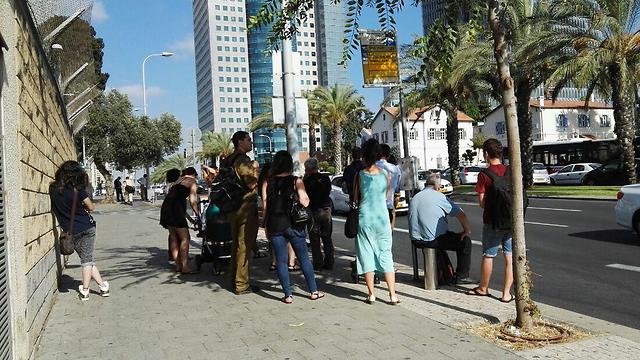
Kaplan Street
Sweating at the bus stops without shade
At the height of August, in central Tel Aviv and other places around the country, those waiting for the bus have no protection from the sun; Ynet spoke with an urban-planning expert on the matter.
The summer is at its height, and those who feel it the most are perhaps those who are waiting for a bus, often without shelter from the sun in temperatures surpassing 30° Celsius.
On Kaplan Street in Tel Aviv and in many other places, waiting passengers are only provided with a bus sign post without any sort of protection from the harsh rays as they wait to get to work. Dr. Yoav Lerman, an expert on urban planning, spoke with Ynet on the matter.
Why don't cities set up proper bus stops, installing instead just a signpost?
"It's principally a question of costs and a decision where to put a structure and where not. It's not possible to put a structure at every stop; it usually requires connecting the electricity infrastructure. The decision needs to have a preference as much as is possible for roofed stops where it's not possible to create the urban conditions that promise proper shade in the day, such as trees or other elements in the area that can ease standing in the sun. Kaplan Street unfortunately doesn't have any element that can ease the situation."
Why hasn't the Tel Aviv Municipality put a structure there? It's a central area; soldiers are coming to IDF headquarters, and shoppers are heading to the Sarona Market.
"It's clearly a matter of costs and also the perception of the road itself. Is that road supposed to serve pedestrians and in what order of priority? Kaplan Street is still not placed high enough in the ladder of municipal priorities, and it is expressed very clearly in its urban design—half of it's a wall." Lerman was referring to the IDF HQ wall that stretches along the street.
What's happening in other cities in the country?
"Bus stops in Israel were planned by one of the best architects, Sir Norman Foster, but there were planned in the best case for cool weather, and they're also not great in rain. The main interest of this stop is external maintenance expenditure. The cities don't maintain the stops, but rather the firms that for them, it's an advertizing space that works well, and in this aspect, the stops are very successfully; they're also aesthetic. The problem is the public interest is that using the stop also be pleasant."
What should be done to find a solution that would best serve the public?
"Decision makers for tenders like this should worry about stops with thermal comfort. Unfortunately, cheap solutions have not been developed because in nearly the entire Western world, there's cool weather.
"We could learn from what they've done in Australia, which is also a Western country that suffers from very hot temperatures and see how we can design a cheap and aesthetic stop that allows for climate comfort in very hot weather that wouldn't be a catastrophe.
"The public interest is that the stop will permit its users to pass through daily with ease, not reaching a point of bathing in their own sweat. The regulator needs to protect us, and in this case it's not certain that they've taken the most correct decisions. Every mayor can come and stand and few minutes at a stop and decide if that's how he's taking care of the public interest."











